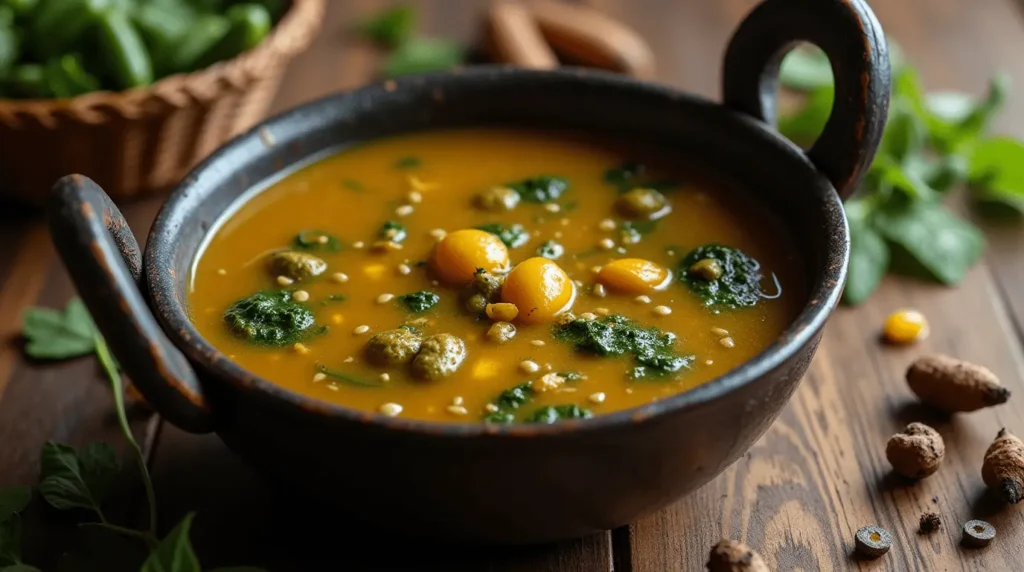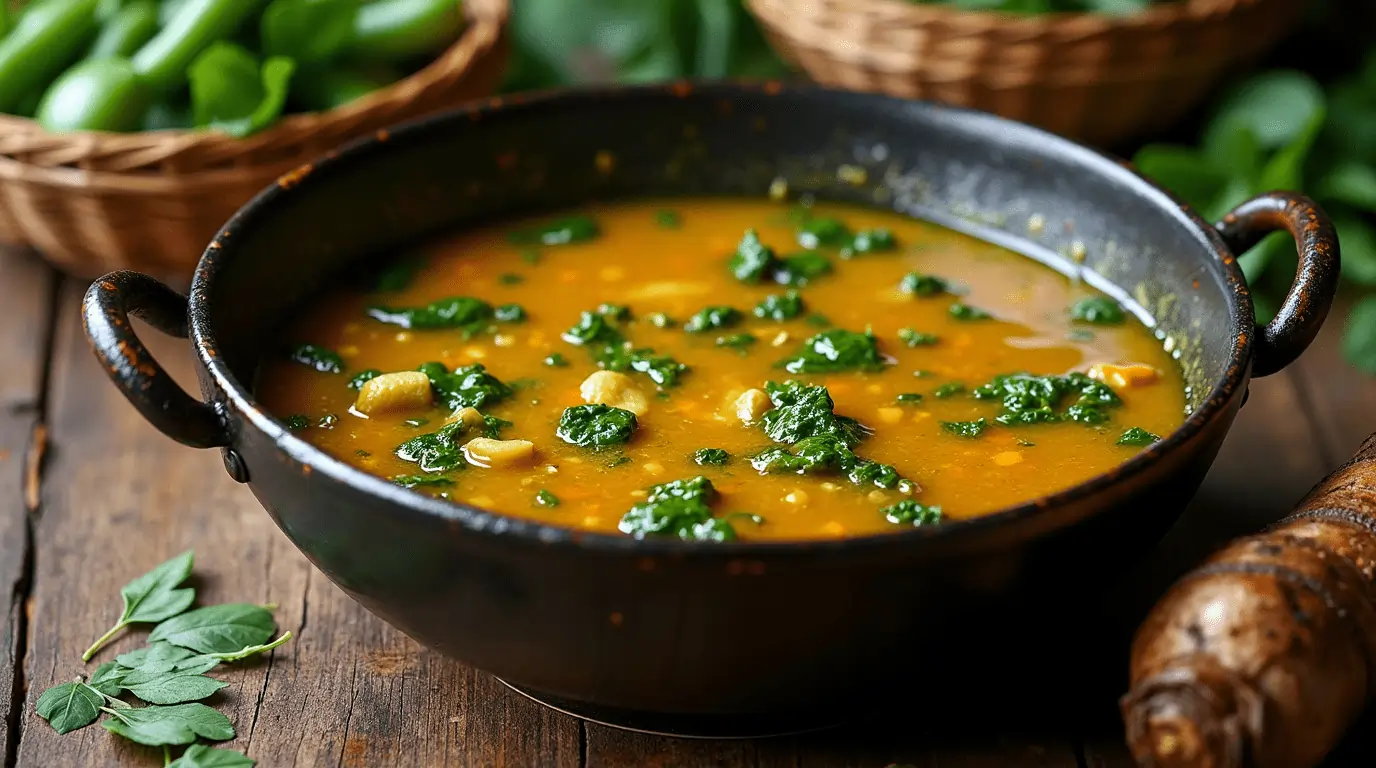Introduction to Fresn Green Sundakai Sambar
Fresh green sundakai sambar recipe is a timeless South Indian dish that celebrates the vibrant flavors of turkey berry, also known as sundakai. This aromatic and hearty sambar is not just a culinary delight but also a powerhouse of nutrition. At the heart of this recipe is the humble sundakai, a small, green berry that imparts a subtle bitterness, making it an essential ingredient in many traditional dishes. When combined with tamarind, lentils, and an array of spices, it transforms into a mouthwatering, wholesome meal.
The fresn green sundakai sambar recipe draws on the rich history of South Indian cuisine, where sundakai is revered for its numerous health benefits. High in vitamins, minerals, and antioxidants, sundakai supports digestion and boosts overall well-being. This dish is not only satisfying to the palate but also offers a unique blend of flavors—from the mild bitterness of the turkey berry to the tanginess of tamarind, perfectly balanced by a blend of spices.
Whether you’re a seasoned cook or new to South Indian cuisine, preparing a fresn green sundakai sambar recipe at home is a fulfilling experience. Its simple yet robust flavors make it a staple in many households, perfect for serving with rice, idli, or dosa.
Table of Contents
Why Use Fresh Green Sundakai in Sambar?
Incorporating fresh green sundakai in your sambar brings a distinctive depth of flavor that cannot be replicated with other ingredients. The slight bitterness of sundakai adds a unique contrast to the tangy tamarind and the rich spices, creating a well-balanced dish. In a fresn green sundakai sambar recipe, the berry’s natural properties enhance the nutritional value, providing a potent source of vitamins, minerals, and antioxidants. Additionally, sundakai supports digestion and gut health, making it a functional addition to any meal. The vibrant, earthy flavor it imparts elevates the sambar, ensuring every bite is both satisfying and nourishing. Here’s why fresn green sundakai is the ideal choice for sambar:

Nutritional Benefits of Sundakai
- High in Vitamins and Minerals
Rich in essential nutrients like vitamin C, calcium, and iron, sundakai supports immune health, strengthens bones, and combats fatigue. - Packed with Antioxidants
Sundakai is a natural source of antioxidants, which protect the body from harmful free radicals and reduce the risk of chronic illnesses. - Promotes Gut Health
The high fiber content in sundakai aids digestion and alleviates common digestive issues. Its antimicrobial properties also contribute to a healthier gut microbiome.
Distinct Flavor Profile of Fresn Green Sundakai
- Mild Bitterness Balanced by Tamarind
The slight bitterness of sundakai is beautifully tempered by the tangy tamarind used in sambar, creating a balanced and flavorful dish. - Versatile Pairing with Vegetables
Sundakai pairs seamlessly with other vegetables like drumsticks, brinjal, and okra, enhancing the overall taste and texture of the dish.
Ingredients for Fresn Green Sundakai Sambar Recipe
A well-prepared sambar begins with the right ingredients. Here’s what you’ll need:
Essential Ingredients
- Fresn green sundakai: The hero of the dish, providing its signature taste.
- Toor dal (split pigeon peas): Adds creaminess and protein to the dish.
- Tamarind: Delivers the tangy kick essential to sambar.
- Sambar powder: A blend of aromatic spices that forms the heart of the dish.
- Curry leaves and mustard seeds: Infuse the sambar with a traditional South Indian aroma.
Optional Vegetables for Added Flavor
Enhance the dish with vegetables like carrots, drumsticks, brinjal, or okra. These not only add variety but also boost the nutritional content.
Tips for Selecting Fresh Ingredients
- Choose sundakai that are firm, evenly green, and free of blemishes.
- Opt for fresh tamarind over packaged varieties for an authentic taste.
- Use high-quality sambar powder for a flavorful base.
Step-by-Step Guide to Making Fresn Green Sundakai Sambar
To prepare a perfect fresn green sundakai sambar recipe, start by sautéing mustard seeds, curry leaves, and dried red chilies. Add the cleaned and soaked sundakai, allowing it to soften. Then, introduce tamarind pulp and turmeric for tang and color. Simmer, and add cooked toor dal, blending everything for a creamy consistency. Finally, season with sambar powder and allow the flavors to meld together. A final tempering of spices adds that authentic touch, completing this flavorful, nutritious dish.
Preparing the Sundakai
- Rinse the sundakai thoroughly to remove dirt and impurities.
- Slice each berry in half to check for seeds and soak them in salted water for 15 minutes. This process helps mellow the bitterness while preserving the nutritional benefits.
Cooking the Sambar Base
- Heat oil in a pan and temper with mustard seeds, curry leaves, and dried red chilies.
- Sauté the soaked sundakai until they begin to soften.
- Incorporate tamarind water, a pinch of turmeric, and salt. Simmer until the tamarind’s tangy essence blends with the sundakai.
Combining the Ingredients
- Cook toor dal until it’s soft and creamy, then mash it lightly.
- Add the dal to the tamarind and sundakai mixture, stirring well to combine.
- Mix in sambar powder and allow the sambar to simmer on low heat, letting the flavors meld together.
- Finish with a final tempering of curry leaves, mustard seeds, and asafoetida for an authentic touch.
Pro Tips and Common Mistakes to Avoid
Crafting the perfect sundakai sambar requires a few tips and tricks to get the flavors just right:
Pro Tips
- Balance the Bitterness
In a fresn green sundakai sambar recipe, balancing the bitterness of sundakai is essential. To achieve this, incorporate tamarind and a touch of jaggery or sugar, which counteracts the bitter notes while enhancing the dish’s overall flavor. A careful mix of spices further harmonizes the bitterness, creating a delightful, well-rounded sambar. - Achieve the Right Consistency
In a fresn green sundakai sambar recipe, achieving the right consistency is crucial. The sambar should be neither too thick nor too watery. Add cooked toor dal and allow it to simmer, adjusting the water level to reach a smooth, slightly thick texture. This balance ensures a perfect, velvety sambar ideal for pairing with rice.
Common Mistakes to Avoid
- Overcooking Sundakai
Cook sundakai just enough to retain their slight crunch. Overcooking can turn them mushy and alter the dish’s texture. - Skipping the Tempering
Tempering is crucial for adding depth and aroma to the dish. Ensure it’s done with fresh spices for the best results.

Serving, Variations, and Storage Suggestions
Best Meal Pairings
Sundakai sambar is traditionally served with steamed rice, ghee, and crispy papad. It also pairs wonderfully with idlis or dosas for a wholesome breakfast.
Variations to Try
- Regional Adaptations
Some regions add coconut paste to the sambar for a richer flavor, while others prefer a spicier version with additional red chilies. - Seasonal Customizations
Incorporate seasonal vegetables like radish, beans, or squash to give the dish a fresh twist.
Storing and Reheating Tips
- Store any leftover sambar in an airtight container and refrigerate it for up to two days.
- Reheat on a low flame, adding a splash of water to regain the desired consistency.

Fresn green sundakai sambar recipe
Ingredients
- 1 cup Fresh Green Sundakai (Turkey Berries)
- ½ cup Toor Dal (Split Pigeon Peas)
- 1 small ball Tamarind
- 1-2 tbsp Sambar Powder
- ½ tsp Mustard Seeds
- 8-10 leaves Curry Leaves
- 2-3 Dried Red Chilies
- 1 pinch Asafoetida (Hing)
- ¼ tsp Turmeric Powder
- Salt
- 4-5 cups Water
Instructions
- Soak the Sundakai: Soak the fresh green sundakai in water for 10 minutes to reduce bitterness.
- Cook the Dal: Pressure cook the toor dal until soft and set aside.
- Prepare the Tamarind: If using fresh tamarind, soak it in water and extract the pulp.
- Temper the Spices: In a pan, heat oil, and add mustard seeds, dried red chilies, curry leaves, and asafoetida. Sauté for a few seconds until fragrant.
- Add Sundakai and Sambar Powder: Add the soaked sundakai and sauté until they soften. Then, add the sambar powder and turmeric powder. Stir well.
- Combine Dal and Tamarind: Add the cooked dal and tamarind extract (or paste). Mix well, adjust water, and bring it to a simmer.
- Cook and Final Touches: Let the sambar simmer for 10-15 minutes. Adjust salt to taste.
- Serve: Serve hot with rice, papad, or any side of your choice.
Notes
- Customize Vegetables: You can add drumsticks, carrots, and brinjal to enhance the flavor of your sambar.
- Balancing Bitterness: Soaking the sundakai helps reduce the bitterness. You can also add jaggery for a slight sweetness.
- Consistency: Adjust the water based on whether you prefer a thicker or more soupy sambar.
Frequently Asked Questions About Sundakai Sambar
What Makes Sundakai Sambar Unique?
The uniqueness of fresn green sundakai sambar recipe lies in its distinctive blend of flavors. The mild bitterness of sundakai (turkey berry) complements the tangy tamarind and the aromatic warmth of traditional spices beautifully. This balance creates a complex, earthy profile that sets it apart from other sambar varieties. Moreover, the nutritional benefits of sundakai—rich in vitamins and antioxidants—add an extra layer of appeal, making it both a flavorful and health-boosting dish.
How Can I Reduce the Bitterness of Sundakai?
To reduce the bitterness in the fresh green sundakai sambar recipe, soaking the sundakai in salted water for 15-20 minutes before cooking can significantly help. Additionally, pairing it with tangy tamarind and balancing with a touch of jaggery or sugar enhances the flavor profile. The careful use of spices like cumin, coriander, and asafoetida also works to mask and balance the bitterness, creating a well-rounded and savory sambar.
Is it possible to use tamarind paste in place of fresh tamarind?
Yes, you can substitute tamarind paste for fresh tamarind in a fresn green sundakai sambar recipe. Tamarind paste is more concentrated, so it should be used sparingly—approximately one tablespoon for every ¼ cup of fresh tamarind pulp. Adjust the amount based on your preferred tanginess level. Tamarind paste may lack the subtle freshness of fresh tamarind but still imparts the necessary sourness, ensuring your sambar retains its authentic flavor.
Is This Recipe Suitable for Meal Prepping?
The fresn green sundakai sambar recipe is ideal for meal prepping. Its robust flavors improve with time, allowing it to develop even more depth when stored. The sambar can be refrigerated for up to 3-4 days or frozen for longer shelf life. Simply reheat before serving, and it will retain its delicious taste and nutritional value. This makes it a convenient and nutritious option for busy days, ready to complement any meal with minimal effort.
How to eat sundakkai?
Sundakkai, or turkey berry, can be enjoyed in a variety of ways, with fresn green sundakai sambar recipe being one of the most popular preparations. The berries are typically added to sambar, where their mild bitterness is balanced by tangy tamarind and spices. They can also be sautéed, pickled, or used in curries. When preparing sundakkai, it’s essential to remove the bitterness through soaking or cooking. This helps mellow the flavor while retaining the berry’s unique nutritional benefits.
Can we eat raw Sundakkai?
Raw sundakkai (turkey berry) is generally not recommended due to its naturally bitter taste, which can be harsh on the palate. However, when prepared in dishes like fresn green sundakai sambar recipe, the bitterness is balanced out by tamarind and spices, making it more palatable. Consuming raw sundakkai in large quantities can cause digestive discomfort, so it is best to cook or soak the berries to reduce their bitterness and enhance their flavor before eating.
Conclusion: Enjoy the Health and Flavor of Sundakai Sambar
The fresn green sundakai sambar recipe is a delightful dish that brings vibrant flavors and offers various health benefits. The unique bitterness of sundakai, when balanced with the tangy tamarind and a blend of spices, creates a deliciously aromatic sambar that is sure to please any palate. This dish is a perfect addition to your diet, as it is rich in antioxidants, aids digestion, and supports overall well-being. The versatility of fresh green sundakai sambar recipe allows it to be customized with various vegetables, making it suitable for all tastes and preferences. Whether served with rice or enjoyed as a side dish, this sambar is satisfying and nutritious. Its ease of preparation and nutritional richness make it an excellent choice for busy weeks, ensuring that you enjoy both health and flavor in every bite.

